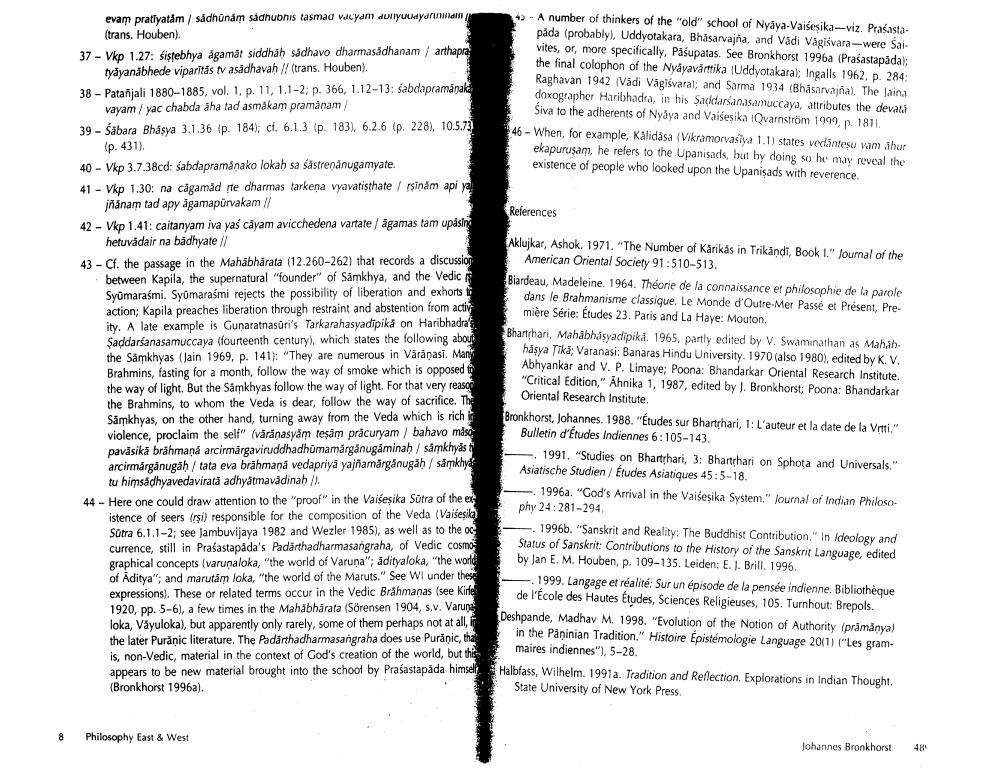Book Title: Peacocks Egg Bhartrhari On Language And Reality Author(s): Johannes Bronkhorst Publisher: Johannes Bronkhorst View full book textPage 8
________________ - A number of thinkers of the "old" school of Nyaya-Vaiśesika-viz. Prasastapada (probably), Uddyotakara, Bhasarvajna, and Vadi Vagišvara-were Saivites, or, more specifically, Pasupatas. See Bronkhorst 1996a (Prasastapada: the final colophon of the Nyayavarttika (Uddyotakaral: Ingalls 1962. p. 284: Raghavan 1942 (Vadi Vāgiśvaral; and Sarma 1934 (Bhasarvajna). The laina doxographer Haribhadra, in his Saddarsanasamuccaya, attributes the devata Siva to the adherents of Nyaya and Vaišesika IQvarnström 1999, p. 1811. 46 - When, for example, Kalidasa (Vikramorvasiya 1.1) states vedāntesu vam ihur 6 ekapuruşam, he refers to the Upanisads, but by doing so he may reveal the existence of people who looked upon the Upanişads with reverence. 4 References evam pratlyatám / sadhünám sadhubnis tasmad wcyam duyuldur (trans. Houben). 37 - Vkp 1.27: sistebhya agamåt siddhah sadhavo dharmasadhanam / arthapra tyāyanabhede viparītas tv asadhavah // (trans. Houben). 38 - Patañjali 1880-1885, vol. 1. p. 11, 1.1-2; p. 366, 1.12-13: sabdapramanaka vayam / yac chabda aha tad asmakam pramanam/ 39 - Sabara Bhasya 3.1.36 (p. 184); cf. 6.1.3 (p. 183), 6.2.6 (p. 228), 10.5.73 3.10.183), 6.2.6 (p. 228), 10.573 (p. 431), 40 - Vkp 3.7.38cd: Sabdapramanako lokah sa sastrenanugamyate. 41 - Vkp 1.30: na cagamad ļte dharmas tarkena vyavatisthate / sinam api ya janam tad apy agamapurvakam // 42 - Vkp 1,41: caitanyam iva yas cāyam avicchedena vartate / agamas tam upasin hetuvadair na badhyate // 43 - Cf the passage in the Mahabharata (12.260-262) that records a discussion between Kapila, the supernatural "founder" of Samkhya, and the Vedic atural founder of Samkhya, and the Vedic Syömarasmi. Syümaraśmi rejects the possibility of liberation and exhorts to action; Kapila preaches liberation through restraint and abstention from activ ity. A late example is Gunaratnashri's Tarkarahasyadipika on Haribhadra's Saddarśanasamuccaya (fourteenth century), which states the following about the Sámkhyas lain 1969. p. 141): "They are numerous in Vārānasi. Many Brahmins, fasting for a month, follow the way of smoke which is opposed to the way of light. But the Samkhyas follow the way of light. For that very reaso the Brahmins, to whom the Veda is dear, follow the way of sacrifice. The Samkhvas on the other hand, turning away from the Veda which is rich he Veda which is rich violence, proclaim the self" (varanasyam tesam pracuryam/ bahavo maso pavasika brahmana arcirmargaviruddhadhumamärganugăminah / sankhyds arcirmärganugah / tata eva brahmanā vedapriya yajñamärganugah / samkhy tu himsadhyavedavirata adhyatmavadinah/). 44 - Here one could draw attention to the "proof" in the Vaiseșika Sūtra of the exs istence of seers (rsi) responsible for the composition of the Veda (Vai esika Sotra 6.1.1-2; see Jambuvijaya 1982 and Wezler 1985), as well as to the c currence still in Prasastapäda's Padarthadharmasangraha, of Vedic cosmo Vedic cosmo oranhical concepts (varunaloka. "the world of Varuņa", adityaloka, "the world of Aditya"; and marutăm loka, "the world of the Maruts." See WI under these ceinnel Thece or related terms occur in the Vedic Brahmanas se ne Vadim Brahmanas (see Kides 1920, pp. 5-6), a few times in the Mahabharata (Sorensen 1904, s.v. Varung loka, Váyuloka), but apparently only rarely, some of them perhaps not at all, the later Puranic literature. The Padarthadharmasangraha does use Puranic, that is, non-Vedic, material in the context of God's creation of the world, but this appears to be new material brought into the school by Prasastapada himself the schoot by Prasastapada himsel (Bronkhorst 1996a). Aklujkar, Ashok. 1971. "The Number of Kärikäs in Trikāndi, Book I." Journal of the American Oriental Society 91:510-512 Biardeau, Madeleine. 1964. Théorie de la connaissance et philosophie de la parole dans le Brahmanisme classique. Le Monde d'Outre-Mer Passé et Présent, Pre mière Série: Études 23. Paris and La Haye: Mouton. Bharthari, Mahabhasyadipika. 1965, partly edited by V. Swaminathan as Mahab. hasya Tika; Varanasi: Banaras Hindu University. 1970 (also 1980), edited by K. V. Abhyankar and V. P. Limaye: Poona: Bhandarkar Oriental Research Institute. Abhyankar and V. P. Limaye: Poona: Bhan "Critical Edition," Ahnika 1, 1987, edited by J. Bronkhorst: Poona: Bhandarkar Oriental Research Institute Bronkhorst, Johannes. 1988. "Etudo eur Rose Bronkhorst, Johannes, 1988. "Etudes sur Bhartrhari, 1: L'auteur et la date de la Vrtti." Bulletin d'Etudes Indiennes 6:105-142 - 1991. "Studies on Bharthari, 3: Bharthari on Sphota and Universals." Asiatische Studien / Etudes Asiatiques 45:5-18. - 1996a. "God's Arrival in the Vaišesika System." Journal of Indian Philoso phy 24:281-294, ! - 1996b. "Sanskrit and Reality. The Buddhist Contribution." In Ideology and Status of Sanskrit: Contributions in the Status of Sanskrit: Contributions to the History of the Sanskrit Language, edited by Jan L. M. Houben, p. 109-135, Leiden: Fl Brill 100 - 1999. Langage et réalité: Sur un épisode de la pensée indienne. Bibliothèque de lécole de d e i'tcole des Hautes Etudes, Sciences Religieuses, 105. Turnhout: Breools. ter tudo Deshpande, Madhav M. 1998. "Evolution of the Deshpande, Madhav M. 1998. "Evolution of the Notion of Authority (pramanya) in the Påninian Tradition." Histoire Epistemologie Language 20(1) "Les gramin the Paninian Tradition." Histoire Epistemolo maires indiennes"), 5-28. Halbfass. Wilhelm Halbfass, Wilhelm. 1991a. Tradition and Reflection. Explorations in Indian Thought. 1991 State University of New York Press 8 Philosophy East & West Johannes Bronkhorst 48Page Navigation
1 ... 6 7 8 9
